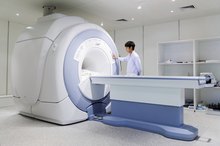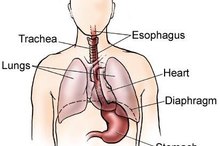What does fact checked mean?
At Healthfully, we strive to deliver objective content that is accurate and up-to-date. Our team periodically reviews articles in order to ensure content quality. The sources cited below consist of evidence from peer-reviewed journals, prominent medical organizations, academic associations, and government data.
- National Library of Medicine: Feeding Tube Insertion
- National Library of Medicine: Jejunostomy Feeding Tube
- The Mayo Clinic: Tube Feedings
The information contained on this site is for informational purposes only, and should not be used as a substitute for the advice of a professional health care provider. Please check with the appropriate physician regarding health questions and concerns. Although we strive to deliver accurate and up-to-date information, no guarantee to that effect is made.
What Are the Different Types of Feeding Tubes?
Placing a tube within the gastrointestinal tract for diagnostic or therapeutic purposes is medically termed as gastrointestinal intubation, according to “Understanding Medical Surgical Nursing” by Linda Williams and Paula Hopper 1. A variety of different feeding tubes exist, with each one used for a specific treatment. The main purposes for feeding tubes include removing gas and fluids from the stomach, providing nutrition and hydration, promoting healing after surgery, removing toxic substances from the stomach and to diagnosing gastrointestinal motility.
Nasogastric Feeding Tube
Doctors use a nasogastric tube (NG tube) when the need for gastrointestinal intubation will take place for less than four to six weeks, per Merck. Medical personnel insert the NG tube in the nostril of either conscious or unconscious patients. This tube passes down the esophagus and into the stomach. Once inserted, placement verification by x-ray and the aspiration (drawing up a substance) of gastric (stomach) content ensures proper function, states Williams and Hopper. Only trained professionals like doctors and nurses prove qualified to place an NG tube.
- Doctors use a nasogastric tube (NG tube) when the need for gastrointestinal intubation will take place for less than four to six weeks, per Merck.
- Once inserted, placement verification by x-ray and the aspiration (drawing up a substance) of gastric (stomach) content ensures proper function, states Williams and Hopper.
Gastrostomy Feeding Tube
Dobbhoff Feeding Tube Vs. PEG
Learn More
Placed in the stomach either surgically, endoscopically,or radiologically, the gastrotomy feeding tube (G tude) is a permanent device, according to Merck. G tube placement happens when the estimated need goes beyond four to six weeks. The National Library of Medicine states, the physician inserts a balloon or special tipped tube into the stomach through a small incision made on the left side of the stomach and sutures the opening closed around the tube 23.
Jejunostomy Feeding Tube
A jejunostomy feeding tube (J tube) is a permanent feeding tube placed in the small intestine 3. Physicians implace the J tube surgically nto the small intestine in order to deliver the required nutrition and medications to the affected person. When they cannot use a G tube and a bowel obstruction exists above the small intestine, physicians will opt to use a J tube instead, says Merck. Physicians can easily pull this tube out during in an inpatient setting. Administration of diluted feedings through this tube in smaller volumes remains the protocol 4.
Esophagostomy Feeding Tube
Isocal Nutrition Information
Learn More
Although the use of an esophagostomy feeding tube proves more practical in the use of animals, human patients affected with malnutrition can also benefit from this device, according to Williams and Hopper. The esophagostomy tube can be placed, with minor equipment, directly into the esophagus. This tube can be used for people or animals that need gastrointestional intubation for a short period. The esophagostomy tube is beneficial to a person when damage to the nasal cavity or jaw prevents nasogastric placement.
- Although the use of an esophagostomy feeding tube proves more practical in the use of animals, human patients affected with malnutrition can also benefit from this device, according to Williams and Hopper.
Related Articles
References
- "Understanding Medical Surgical Nursing"; by Linda Williams and Paula Hopper; 2003
- National Library of Medicine: Feeding Tube Insertion
- National Library of Medicine: Jejunostomy Feeding Tube
- The Mayo Clinic: Tube Feedings
- Sullivan SN. Functional abdominal bloating with distention. ISRN Gastroenterol. 2012;2012:721820. doi:10.5402/2012/721820
- The Oral Cancer Foundation. Nutrition/feeding systems.
- Philpott H, Garg M, Tomic D, Balasubramanian S, Sweis R. Dysphagia: Thinking outside the box. World J Gastroenterol. 2017;23(38):6942–6951. doi:10.3748/wjg.v23.i38.6942
- Blumenstein I, Shastri YM, Stein J. Gastroenteric tube feeding: techniques, problems and solutions. World J Gastroenterol. 2014;20(26):8505-24. doi:10.3748/wjg.v20.i26.8505
- U.S. National Library of Medicine. MedlinePlus. Jejunostomy feeding tube. Reviewed October 29, 2018.
- American Society for Gastrointestinal Endoscopy. Understanding percutaneous endoscopic gastrostomy (PEG).
- U.S. National Library of Medicine. MedlinePlus. Feeding tube insertion - gastrostomy. Reviewed May 20, 2018.
Resources
- "Basic Nursing"; by Patricia Potter and Ann Perry; 2003
Writer Bio
Annie McElfresh is a nurse by trade and an avid writer by night. Her background includes 10 years of experience in pain management, operating room, home health, and medical office management. She has completed two full-length novels, contributes to two blogs, and is a member of several writing forums.









